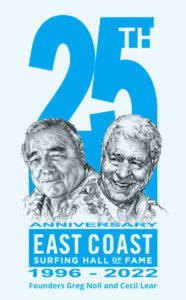
Designed by artist Phil Roberts (Class of 2016), the 25th Anniversary logo features illustrations of co-founders Greg “Da Bull” Noll and Cecil Lear.
A Simple Mission Endures
By Andrew Lewis
The East Coast Surfing Hall of Fame began with Cecil Lear and Greg Noll’s belief that the Right Coast deserved some respect. Gary Germain vows to keep it that way.
In retrospect, the breezy days of the longboard age and Gidget and the Beach Boys vaporized overnight. Suddenly, surfing was swept up in the stormy, transformative years of the Sixties. For those surfers who came up then, there is perhaps no more powerful a symbol of this momentous time than the shortboard, its sharp edges and angles a perfect metaphor for an era abruptly lopped, altered, made to be driven in a radically different way. On the East Coast, the rise of the shortboard signaled the beginning of a unique surf culture, led by a small tribe of wave-riders in beach towns from Maine to Texas.
In November of 1967, a thirty-seven-year-old surfer named Cecil Lear, who had been riding waves since childhood but hadn’t actually stood up until he was thirty-one, co-created the Eastern Surfing Association. Cecil, a tall, infectiously easy-going lifeguard from Belmar, New Jersey, and his buddy from New York, Rudy Huber, kicked off the inaugural ESA season the following year with a circuit that spanned from First Beach, Rhode Island to Cocoa Beach, Florida. It was the first time that East Coast surfers, our numbers spread thin by our expansive coast, were united.
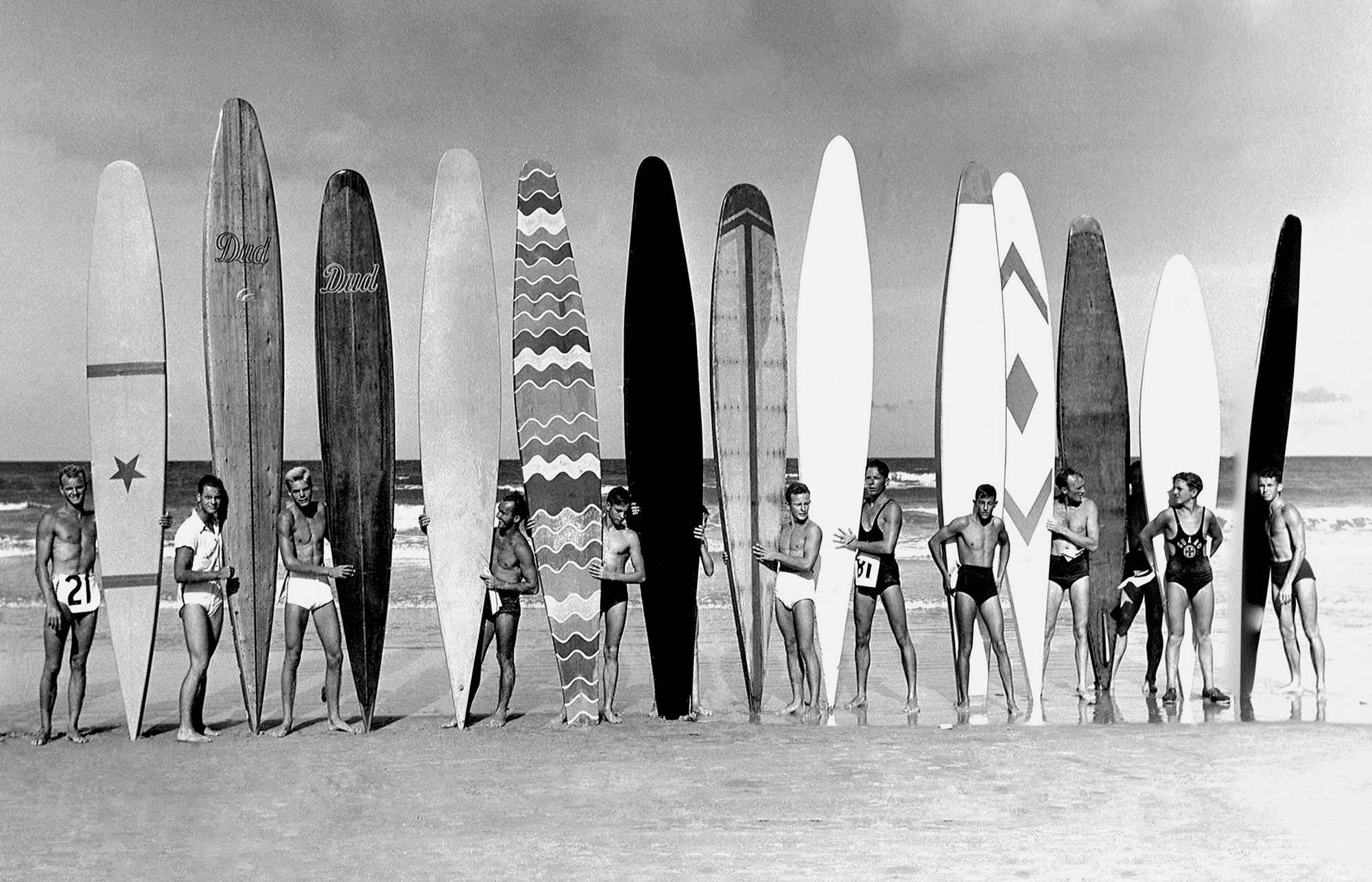
Long before the shortboard and Greg Noll thought of an East Coast Surfing Hall of Fame, there were surfers riding waves in Daytona Beach, Florida and in other beach towns dotting the East Coast. Circa 1932.
At the same time that Lear and Huber’s ESA began to grow rapidly, California’s famous board-builders were flooding the surf shops just opening their doors in the same beach towns the ESA visited. By the end of the Sixties, Hobie, Dewey Weber, Bing, Hanson, and Greg Noll were doing regular trips back East with their teams, further spreading their infectious Southern California surf lifestyle with every visit. But for Greg Noll, there was something special about his East Coast brethren that he didn’t want to see diluted by California influence.
“On the West Coast back then, surfing basically spanned a hundred-fifty miles of coast; everybody knew everybody, and all the magazines were there,” Greg told us in 2016. “The West Coast guys got all the glory, all the recognition, and the East Coast guys were just out there hanging.”
From the very beginning, the resentment that East Coast surfers felt from being ignored compared to their Californian counterparts rubbed Greg the wrong way. “They were surfers, too,” he said. “But they were getting shit on. They deserved something, too.”

East Coast Surfing Hall of Famers deserve the attention and credit they receive from being inducted. They can also proudly wear the Hall of Fame’s custom designed ring. Photos Mez / ESM.
Over the next twenty-five years, as the days of Hobie and Weber and Noll team tours faded out, Cecil Lear and Rudy Huber passed on the torch to dedicated executive directors like Colin “Doc” Couture and Kathy Phillips, who grew the ESA into a competitive juggernaut and nurtured the ambitions of kids like Frieda Zamba, Lisa Andersen, Kelly Slater, and the Lopez and Hobgood brothers—all East Coasters who became some of the best surfers our sport has ever seen.
***
By 1994, Greg was thinking a lot about those old trips up and down the East Coast. So many years had gone by, but still the same thoughts rattled in the back of his mind. “I just thought it would be bitchin’ to do something to tie those guys together,” he said. “Like a family.”
Greg asked around about finding the right person to help him make his idea—an “East Coast Surfing Legends Hall of Fame,” as he called it—a reality. Everyone told him to talk to Cecil Lear. As it happened, Cecil and Greg had crossed paths around 1966, when Greg passed through Belmar on one of his tours, though the two didn’t know it until they reunited at the January 1994 Surf Expo, nearly thirty years later.
“We gotta do this,” Greg told Cecil.
“Geez,” Cecil said, “I hope you do it.”
Greg said he would, but only with Cecil’s help.
Over the next year, Cecil and Greg spent countless hours on the telephone, trying to figure out how the hell they could whittle down the inaugural Hall of Fame class to just twenty. “At first, Greg had about fifty names!” Cecil said in 2016. “I said, ‘Greg, that’s too much. We have to cut it down to ten!’” In the end, they settled for an uneven, but undeniably deserving, twenty-three.
For both Cecil and Greg, the inaugural induction ceremony—held at Surf Expo on the evening of January 13, 1996, in the Valencia Ballroom of the Orange County Convention Center’s West Hall—was nerve-racking. There was no precedent for what they were doing, and they felt that this night would determine the Hall of Fame’s future.

The first Class of 1996 was a star-studded group. How many can you name? (See answers by going to the Hall of Famers page on this website.) Photo Roger Scruggs.
Despite a few last-minute mishaps involving one of the most important aspects of the ceremony—the inductee slideshow—Cecil, Greg and crews from Surf Expo and SIMA pulled together a truly memorable event. As they walked into the ballroom, the air filed with Hawaiian Slack Key and snippets of legendary conversation, Greg turned to Cecil. “Can you believe this?” he asked.
“No,” Cecil said. “I’ve got chicken-skin.”
During the inductions, there were few dry eyes in the ballroom. “The East Coast was finally going to get some recognition for their guys,” said Greg. “There was so much life in that first ceremony.” When it was Greg’s turn to take the stage, he was very clear about his role in the Hall of Fame going forward. “I told everybody, ‘Cecil’s gonna run this thing.’ And then I backed out, and that’s the way it’s been ever since.”
Despite all the hard work he and Greg had done behind the scenes in the two years leading up to the 1996 induction, Cecil was shocked—and remains shocked to this day—that they had pulled the night off. “It was something special,” said Cecil. “The karma, it was there.”
Though Greg stepped away from any involvement in the Hall of Fame as promised, his friendship with Lear remained, as well as his admiration. “If you’re gonna give me credit,” he said, “it’s maybe five percent me and 110 percent Cecil.” No doubt, the two old friends were constantly trying hard to credit the other, but there is no denying that the Hall of Fame wouldn’t be what it is today without their joint effort.
In the two decades that passed after the inaugural 1996 ceremony, Cecil, along with the dedicated help of dozens more of the East Coast’s finest, carried the Hall of Fame through ten more induction ceremonies and 121 more inductees. In their simple wish to honor the men and women who have influenced so many generations of East Coasters, they built an institution that—like our unshakeable passion for riding waves—endured.

ECSHOF co-founders Greg Noll and Cecil Lear, along with Cecil’s wife of over 65 years, Mary Lou. The ones who made the Hall of Fame come alive. Photo Bruce Chrisner.
***
When it came time to arrange the 20th anniversary induction ceremony, it was paramount that this one stood out from all the rest. Cecil convinced Greg and his wife, Laura, to fly over to Orlando from California and be the Hall of Fame’s guests of honor at the event, once again held in a Surf Expo ballroom, on the evening of January 15, 2016.
Cecil and Greg didn’t have to wait in suspense very long—before the ceremony even began, the room was packed to the gills with a raucous crowd, eager to soak in the history that hung heavy in the air, and, of course, to witness the induction of the 20th anniversary class.
When Greg got up on stage, he looked through the lights and over the crowd with that quintessential, deadpan Da Bull gaze. “This,” he said with a smirk, “is one of the best god damn crowds I’ve ever seen!” The crowd roared. When it was Cecil’s turn to take the dais, he was more reserved than his old pal—as usual—but no less moved by the sight before his eyes. He marveled at the force that East Coast surfers have become today. “I just want to thank each one of you for being a part of this family.”
And then he sprung the news: it was time to pass the torch. After overseeing the induction of so many men and women over two decades, Cecil said he would be stepping down as Hall of Fame President. Waiting in the wings was Gary Germain, then the President of the New Jersey Surfing Hall of Fame.
Gary had grown up surfing the rock groins of Sea Bright, on the northern Jersey Shore, and when he entered his first contest as a teenager in 1972, he’d gone ahead and won the whole damn thing. From there, it was a quick ascent through the ranks of the ESA and on to a pro career that took him around the world, from Europe to Africa to Indonesia.
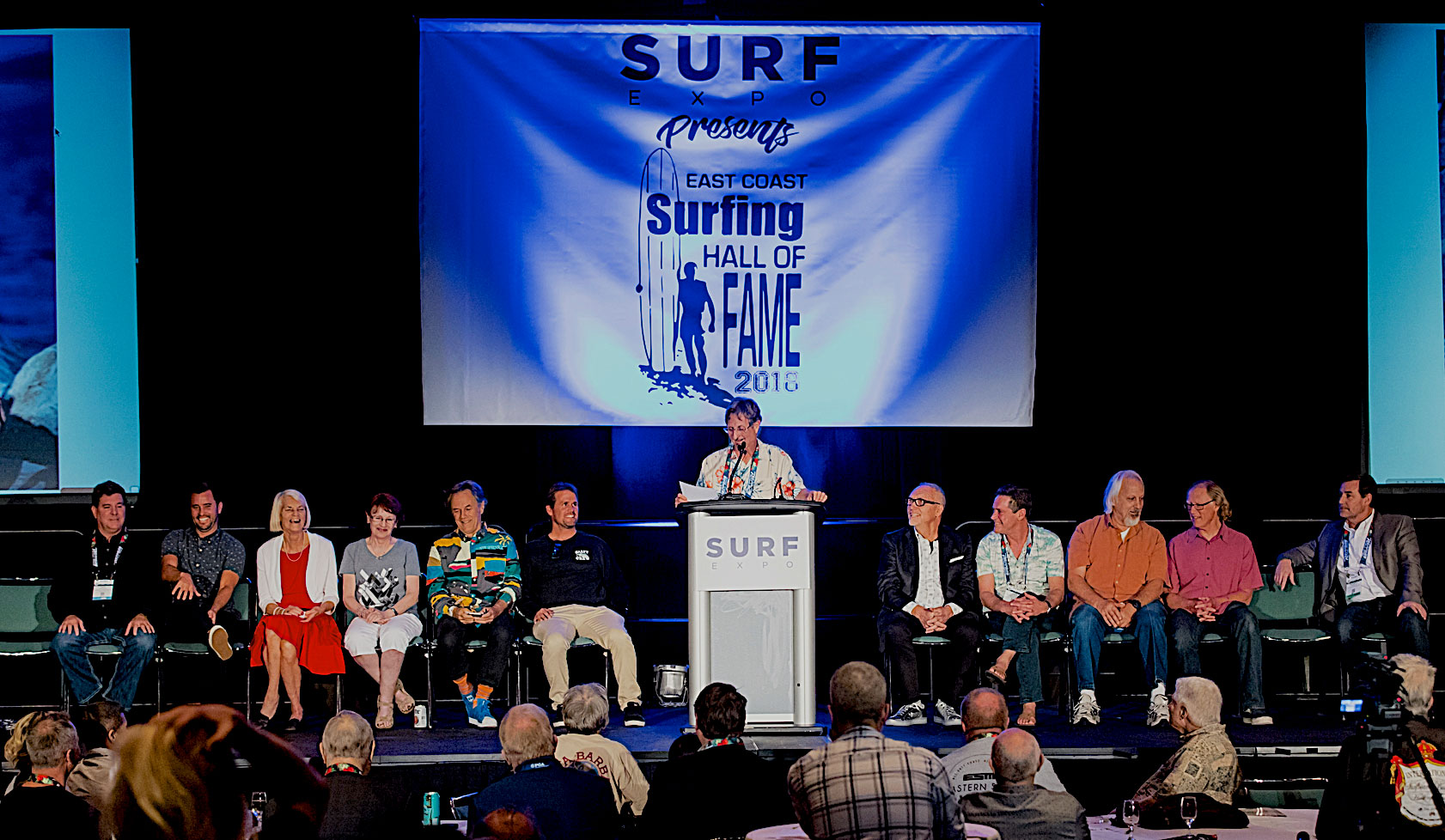
The Class of 2018 Induction was Germain’s first as president. Taking place, as always, during the Surf Expo Trade Show in January in Orlando, Florida, with the help and support of Surf Expo, the title sponsor of every induction since 1996. Photo courtesy Surf Expo.
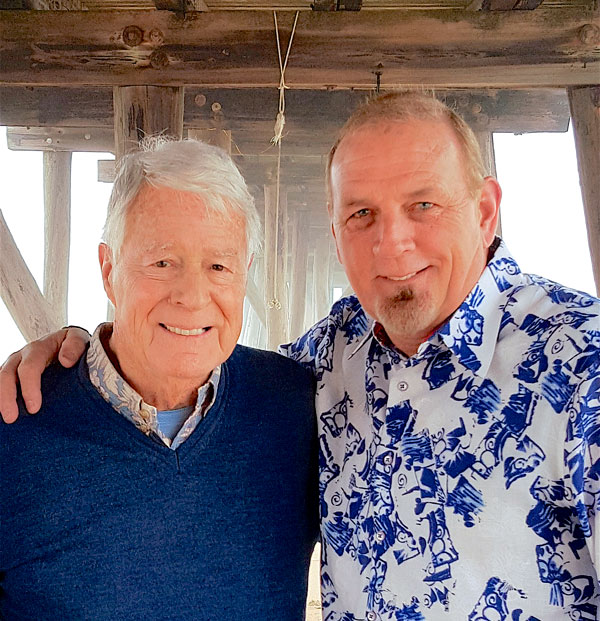
After 20 years as president, Lear turned the reins of the organization to fellow right coast surfer, Gary Germain. Germain left his post as president of the New Jersey Surfing Hall of Fame to take the position in May 2016, leading the organization representing the entire East Coast from Maine to Florida. Photo Bruce Chrisner.
Gary would later start G-Force Surfboards, and, in 1980, become the ESA’s North New Jersey Director. From there, he went on to work in the restaurant industry, eventually landing at Sysco, where he remains today. But a career outside the surf industry did little to dull the flame of Gary’s stoke—he’s still surfing, still traveling, still ripping. “Restauranteurs are much like surfers,” Gary told us shortly after officially taking the Hall of Fame reigns. “Highly creative, social, adaptive, and always searching for the next venture.”
Through his work building the New Jersey Surfing Hall of Fame, Gary was a natural choice to succeed Cecil. “I’ve known Gary for many years,” said Cecil, who is now officially the Hall of Fame’s President Emeritus. “He’s a great surfer and fine person, and I’m confident he’ll bring his passion for and dedication to the sport, his vision, leadership skills and talents to achieving the mission we established twenty-two years ago.”
For his part, Gary was both honored and humbled to be asked to fill such an esteemed position. “Cecil’s a co-founder of the ESA, co-founder of the ECSHOF, and has been inducted into three different halls of fame,” he said. “Big shoes to fill, for sure.”
***
Gary wasted little time getting started. As soon as his new position was made public in March of 2017, he began working with the Hall of Fame’s Board of Directors to narrow down the Class of 2018 and pull together that year’s induction ceremony, which saw ten more East Coast legends welcomed into the Hall of Fame family, as well as a special recognition of Alexander Hume Ford, the South Carolina native who tirelessly promoted the sport of surfing in the early 20th century and helped create Waikiki’s now-iconic Outrigger Canoe Club.
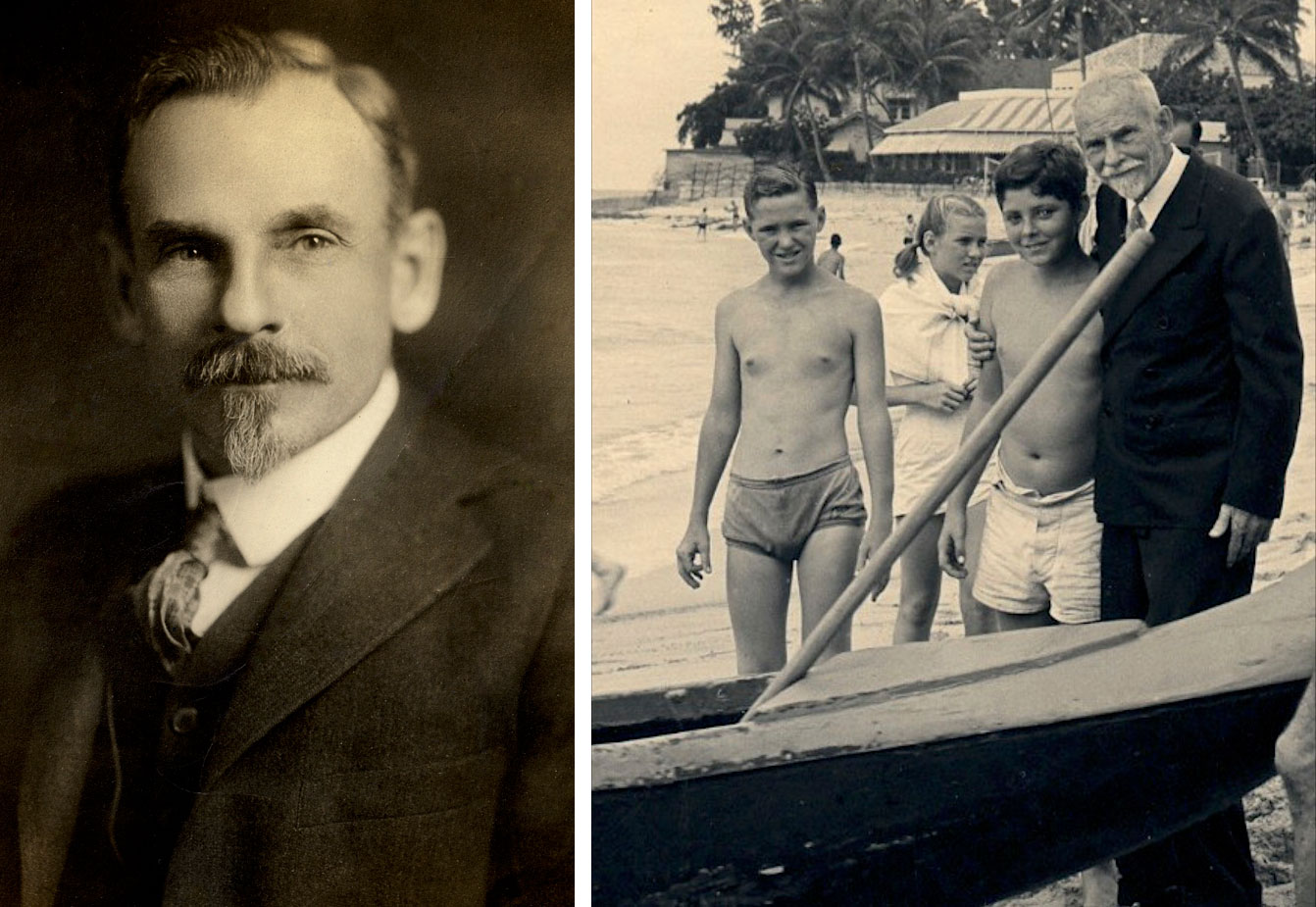
South Carolina’s Alexander Hume-Ford was honored with the Special Recognition Award with the Class of 2018 Induction. Ford, a friend of Duke Kahanamoku, is credited with being the founder of the famous Outrigger Canoe Club in Waikiki. Photos courtesy Outrigger Canoe Club.
Since 2018, Gary has been busy instituting a flurry of changes within the Hall of Fame, most notably the addition of David Scibal, a New Jersey native and former competitive East Coast surfer, to the board, alongside Gary, Cecil, Bob Mignogna, Greg Loehr, and Dick Meseroll. David is also a member of the board of directors at the Surfing Heritage and Culture Center, in San Clemente, California, and is tasked with overseeing the Hall of Fame’s financial development.
Also under Gary’s direction, a brand-new East Coast Surfing Hall of Fame website was born. Launched in December of 2021, the site is anchored by the bios and photos of all 167 members of the Hall of Fame plus the 11 new members of the Class of 22, as well as a photo gallery of the East Coast’s most iconic surf spots.
Gary has also commissioned legendary artist and member of the Class of 2016, Phil Roberts, to create a 25th Anniversary Hall of Fame logo, which is being unveiled in this article and at Surf Expo. Roberts’ work has been featured across the pages of countless surf mags, not to mention Hollywood movie posters and the pages of National Geographic.
A classic Phil Roberts poster is just the tip of the spear for the 2022 festivities in Orlando. Led by marketing whizzes Peter “PT” Townend and the Surfing Heritage and Culture Center’s former Executive Director Glenn Brumage, the 25th induction ceremony is being accompanied by the Surf Legends Vintage Surfboard Auction, run by New Jersey’s Mike Miggs. Up for grabs are over 30 classic crafts, including a 1958 Pat Curren shape, a Miki Dora “Da Cat,” a Greg Noll balsa, and more boards by Bing, Hansen, Webber and other legendary shapers.
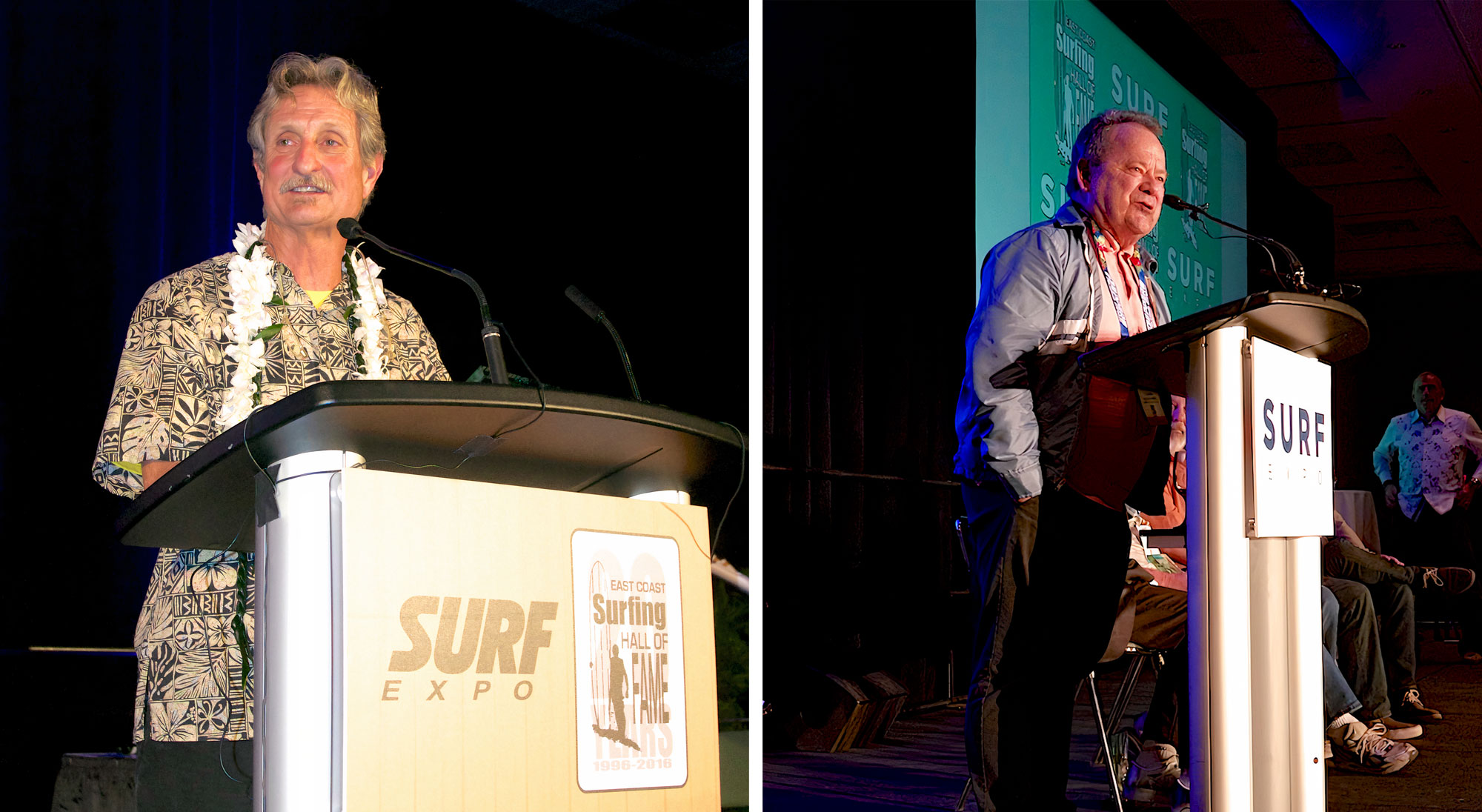
Longtime supporters of East Coast Surfing and the Hall of Fame, and MCs at many of the induction ceremonies, Hunter Joslin (Class of 2018) and Peter “PT” Townend. Photos Bruce Chrisner.
One board that won’t be up for grabs, however, is Miggs’ replica of a 10-foot, Bill Simon alaia, the original of which was shaped for Duke Kahanamoku, who in 1912 introduced surfing to the East Coast. A plaque on the board’s deck features the name of every Hall of Fame inductee. “The board,” Gary said, “will forever enshrine every past and future member.”

Designed by former East Coast surfer, Drew Dougherty, the logo features a drawing of the iconic Greg Noll, ECSHOF co-founder, looking out at second and third reef Pipeline before paddling out into the heavy surf. The image was made famous in the classic 1966 John Severson photo.
More than any other change Gary has helped usher in over the past five years, is the creation of a new East Coast Surfing Hall of Fame logo with multiple versions of the design by New Jersey born surfer designer, Drew Dougherty. In a simultaneous ode to both East Coast surfing history and surf culture in general, one version of the logo, unveiled in 2020, features one of our sport’s most iconic images: Greg Noll in 1964, back turned to the camera, surfboard cradled against a thick shoulder, a massive Pipeline bomb pitching in the distance.
“Especially after his passing,” Gary said of Greg, who left us on June 28, 2021, at the age of 84, “it seemed to make sense to honor him.”
For Gary, there’s tremendous inspiration—and a sense of direction—to be found in the fact that, even after a quarter century, Cecil and Greg remained as committed to the simple idea that, as Greg put it, the East Coast guys “deserved something, too.”
“The ones that stand apart and above, they’re the ones that we celebrate,” Gary said. “That’s our mission.”

